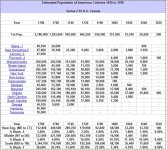I don't know if this has ever been discussed or if anyone has thought about this so apologies if it's a repeat or nobody cares. I was wondering if anyone has done a statistical analysis of the probability of finding a certain type of coin. If you think about year, population of that year, coin type (copper or silver), amount of coins minted and soil factors I think you can probably come up with a formula that would be interesting. I'm not sure if I'm missing anything. Probably can consider wealth factor, i.e. someone in the 1800's is carrying copper pennies and is probably more likely to keep a tight purse whereas people today lose change and don't think twice about it.
What made me think about this are the posting of people who keep logs and sum up all their finds so you can see the variety of coins found. For obvious reasons, silver coins are more prevalent due to its inert qualities and quantity minted but it would be interesting to break down to years or group of years.
Anyway, just a thought.
Thanks
Bob
What made me think about this are the posting of people who keep logs and sum up all their finds so you can see the variety of coins found. For obvious reasons, silver coins are more prevalent due to its inert qualities and quantity minted but it would be interesting to break down to years or group of years.
Anyway, just a thought.
Thanks
Bob

